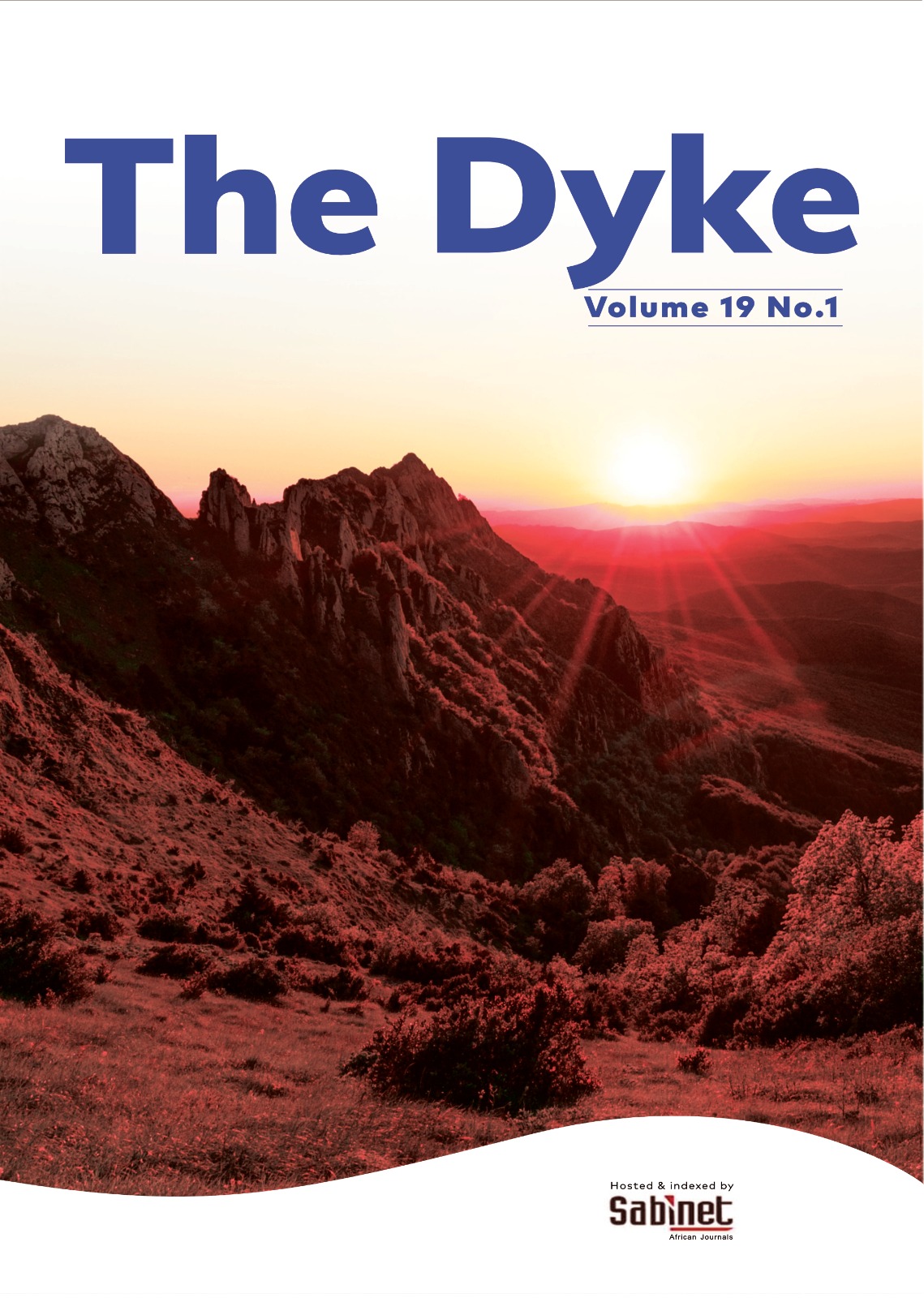Evaluation of Biological Assets (livestock) valuation strategies on providing realistic value: A case study of Gweru Farmers, Zimbabwe
DOI:
https://doi.org/10.64754/thedyke.v19i1.457Keywords:
biological assets, cost approach, fair value, income approach, livestock valuation, market approachAbstract
The paper presents an important and timely study on livestock valuation strategies in Zimbabwe, focusing on their effectiveness in providing realistic valuations. The research is well-structured and explores key valuation methods including the Market Approach, Income approach, Fair Value Approach and Cost Approach. The study is methodologically sound, using a mixed method research design that included surveys and interviews with farmers, valuers and accountants. The discussion highlights gaps in existing valuation practices and suggests hybrid strategies for achieving realistic valuations. Target population focused on 70 commercial livestock farmers, valuers and accountants in Gweru, Zimbabwe. Quantitative analysis focused on the perceived effectiveness of each method, while qualitative insights explored challenges related to valuation accuracy. The Market Approach emerged as the most reliable valuation method for reflecting real-time market conditions, followed by the Fair Value and Cost Approaches, which showed moderate effectiveness. The Income Approach was the least preferred, cited for its speculative nature and limited applicability in volatile markets. The study highlights gaps in existing literature, particularly the absence of empirical evaluations of hybrid valuation methods that integrate multiple approaches to mitigate individual limitations. To achieve realistic valuations, policy makers and farmers are encouraged to adopt hybrid strategies that combine market trends, production costs, and future earning potential. These findings are particularly relevant for developing regions with underregulated markets.
References
Badenhest, V., & Well, V. (2023). The value relevance of fair value measurement. University of Pretoria. https://doi.org/10.1111/auar.12382.
Bakhtiyor, Y. (2024). Improvement of organizational & methodological aspects of identification and accounting of biological assets. Journal of Agricultural Accounting and Economics. https://doi.org/10.1108/S1877-63612024000033A004.
Baruch, Y., & Holtom, B. C. (2023). Survey response rates. Journal of Human Resource Management. https://doi.org/10.1177/0018726708044863.
Beigma, E. (2023). Fair value measurement in inactive markets. Journal of Finance and Accounting Research. https://doi.org/10.1177/0148558X23116557.
Bell, E., Bryman, A., & Harley, B. (2022). Business research methods (6th ed.). Oxford University Press. https://doi.org/10.4324/9781003592808.
Craske, M. G., & Barlow, D. H. (2022). The mastery of your anxiety and panic stimuli on valuation decisions. Behavioral Insights in Economics. https://doi.org/10.1093/med-psych/9780197584057.001.001.
Elad, C. (2022). Biological asset valuation under IAS 41: A review of challenges and opportunities. Journal of International Accounting Research. https://doi.org/10.1093/sermwm.013.
Fama, E. F. (1965). The behavior of stock market prices. Journal of Business.
Flores, C. (2021). Agricultural valuation in developing economies: Structural challenges and policy implications. African Journal of Agricultural Economics, 105(1), 1-21.
FAO. (2023) Food and Agriculture Organization of the United Nations. Global livestock sector report. https://www.fao.org/faostat/en/data.
Joseph, E., & Blandon, R. (2020). Comparative study of difficulties in accounting preparation and judgment in agriculture. Journal of Agricultural Finance and Management.
Kharabanze, E. (2023). Methods of accounting and assessment of biological assets and agricultural products. International Journal of Agricultural Accounting.https://doi.org/10.20472/IAC.2023.017.74.
Kica, P., & Szczypa, M. (2021). Valuation of livestock in farms. Problemy Zarządzania. https://doi.org/10.7172/1644-9584.94.
Krejcie, R. V., & Morgan, D. W. (1970). Determining sample size for research activities. Educational and Psychological Measurement.
Laux, C. (2021). The application of IAS 41 in agricultural enterprises: A global perspective. Accounting Horizons. https://doi.org/10.1257/jep.24.1.9393.
Murty, N. V., & Sastry, R. (2022). Accounting for biological assets: A comprehensive review and analysis. Journal of Agricultural Accounting. https://doi.org/10.48047/IJFANS/V11/ISS7/323.
Ndala, N. (2024). Assessing the extent of compliance with IAS 41 by agricultural entities in Southern Malawi. African Journal of Accounting and Finance. https://doi.org/10.5897/AJM2018.8622.
Nyakurukwa, K., & Seetharan, V. (2023). Analyzing the strong form of market efficiency in agricultural markets. Journal of Agribusiness Studies. https://doi.org/10.1108/JCMS-04-2023-0014.
Pavlov, I. P. (1927). Conditioned reflexes: An investigation of the physiological activity of the cerebral cortex. Oxford University Press.
Rezende, J. A. (2022). Relevance of fair value in biological assets: An experimental analysis. Journal of Agricultural Economics and Valuation. https://doi.org/10.48142/2420221848.
Schrobback, F. (2024). Hybrid valuation approaches for biological assets: A new frontier in agricultural accounting. Journal of International Agribusiness. https://doi.org/10.1016/jfs/2023.100722.
Scott, R. (2023). The regulatory landscape for biological asset valuation in developing economies. Journal of Development Studies. https://doi.org/10.17159/2222-3436/2023/v19n199.
Soprano, A. (2024). Cognitive biases in fact: A psychological perspective. Journal of Behavioral Economics. https://doi.org/10.1016/J.ipm.2024.
Welgrzynska, K., & Nowotarska, A. (2021). Measuring & valuation of biological assets. Journal of Agricultural Valuation and Accounting. https://orcid.org/0000-0003-3967-2632.
Widagdo, K., & Okfitasari, A. (2023). The impact of biological assets disclosure and economic sustainability on firm value. Journal of Environmental and Agricultural Economics. https://doi.org/10.1088/1755-1315/1297/1012069.
Zimbabwe National Statistics Agency. (2023). Annual agricultural economic report: Contribution of livestock to GDP.ZIMSTAT.

Downloads
Published
How to Cite
Issue
Section
License
Copyright (c) 2025 Upon acceptance and publication, authors grant The Dyke a non-exclusive licence to publish and distribute their article in all formats and media. This means: Authors may freely share, deposit, and republish their work (e.g., in institutional repositories, websites, or future publications), provided proper citation and acknowledgment of The Dyke as the original publisher.

This work is licensed under a Creative Commons Attribution 4.0 International License.
All articles in The Dyke are published under the Creative Commons Attribution 4.0 International License (CC BY 4.0).
Under this licence:
- Others may copy, redistribute, remix, transform, and build upon the work for any purpose, even commercially.
- Appropriate credit must be given to the original author(s) and source (The Dyke), along with a link to the license.
- Any changes made must be indicated.
Full licence details: https://creativecommons.org/licenses/by/4.0/
Archiving and Preservation
The Dyke supports long-term preservation of scholarly work through partnerships with digital repositories and indexing services, including Sabinet African Journals. Authors are also encouraged to deposit a copy of their published article in institutional or subject-specific repositories.




